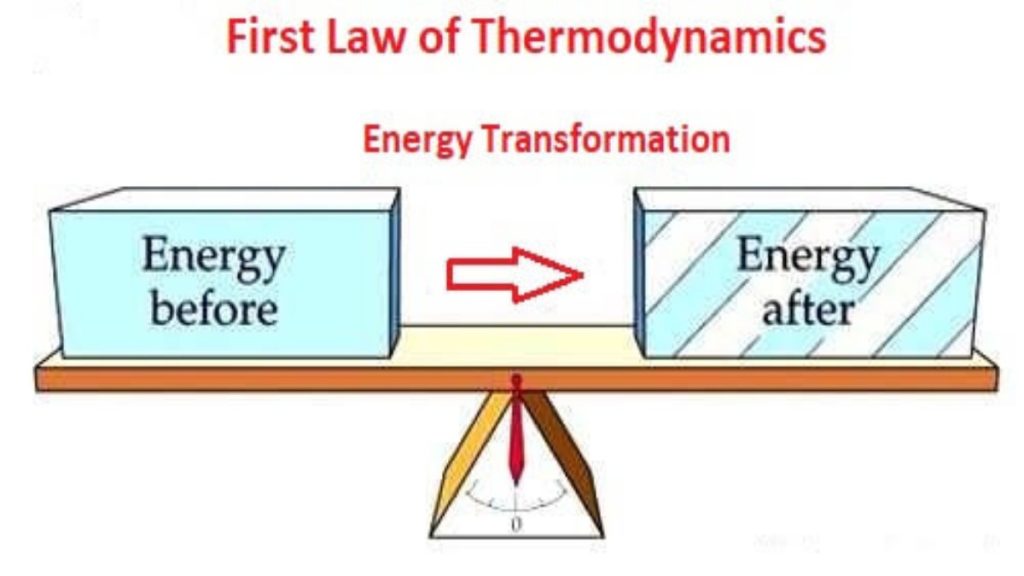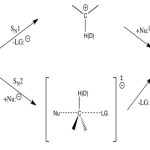Stated simply; The total energy of the universe does not change. This does not mean that the form of the energy cannot change. Indeed, chemical energies of a molecule can be converted to thermal, electrical or mechanical energies.
The internal energy of a system can change only by work or heat exchanges. From this the change in the free energy of a system can be shown by the following equation:
ΔE = q – w
When q is negative heat has flowed from the system and when q is positive heat has been absorbed by the system. Conversely when w is negative work has been done on the system by the surrounding and when positive, work has been done by the system on the surroundings.
In a reaction carried out at constant volume no work will be done on or by the system, only heat will be transferred from the system to the surroundings. The end result is that:
ΔE = q
When the same reaction is performed at constant pressure the reaction vessel will do work on the surroundings. In this case:
ΔE = q – w
where
w = PΔV
When the initial and final temperatures are essentially equal (e.g. in the case of biological systems):
ΔV = Δn[RT/P]
therefore,
w = ΔnRT
By rearrangement of the above equations one can calculate the amount of heat released under constant pressure:
q = ΔE + w = ΔE + PΔV = ΔE + ΔnRT
In this last equation, Δn is the change in moles of gas per mole of substance oxidized (or reacted), R is the gas constant and T is absolute temperature.
Enthalpy
Since all biological reactions take place at constant pressure and temperature the state function of reactions defined to account for the heat evolved (or absorbed) by a system is enthalpy given the symbol, H
The changes in enthalpy are related to changes in free energy by the following equation:
ΔH = ΔE + PΔV
The equation is written in this form because we are addressing the constant pressure situation. In the biological setting most all reaction occur in a large excess of fluid, therefore, essentially no gases are formed during the course of the reaction. This means that the value ΔV, is extremely small and thus the product PΔV is very small as well. The values ΔE and ΔH are very nearly equivalent in biological reactions.
Stated above was the fact that state functions, like ΔH and ΔE, do not depend on the path taken during a reaction. These functions pertain only to the differences between the initial and final states of a reaction. However, heat (q) and work (w) are not state functions and their values are affects by the pathway taken.
Reversible and Irreversible Reactions
In an idealized irreversible reaction such as one done by expanding an ideal gas against zero pressure, no work will be done by or on the system so the:
w = 0
In the case of an ideal gas (whose molecules do not interact) there will be no change in internal energy either so:
ΔE = 0
since ΔE = q – w, in this irreversible reaction q = 0 also.
In a reversible reaction involving an ideal gas, ΔE still will equal zero, however, the pressure will be changing continuously and work (w) is a function of P, work done must be determined over the entire course of the reaction. This result in the following mathematical reduction:
w = RTln[V2/V1]
Since in this situation ΔE = 0, q = w. This demonstrates that some of the heat of the surroundings has to be absorbed by the system in order to perform the work of changing the system volume.
Reversible reactions differ from irreversible in that the former always proceeds infinitely slowly through a series of intermediate steps in which the system is always in the equilibrium state. Whereas, in the irreversible reaction no equilibrium states are encountered. Irreversible reactions are also spontaneous or favorable processes. Thermodynamic calculations do not give information as to the rates of reaction only whether they are favorable or not.



Comments are closed